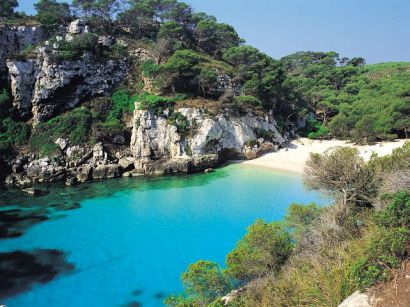
Located in the western Mediterranean Sea around 60 miles from the Iberian coast is the archipelago of the Balearic Islands that forms one of the Autonomous Communities of Spain.
Mallorca, Menorca and Cabrera can be found to the Northern end with Ibiza and Formentera in the Southwest. These wonderful islands have Palma de Mallorca as their capital city and have two officially recognized languages - these being Catalan and Spanish.
There is no wonder that the Balearics are one of the more favoured holiday destinations in Spain, as with over 300 days of sun per year and some of the world's prettiest beaches they offer near perfect conditions for getting away from the stresses and strains of modern life.
As close to each other as they are, each of the islands has a personality all of its own. They have a rich cultural heritage and the locals are extremely accommodating, welcoming the influx of tourists (mainly European) each year with hospitality, which is second to none.
There are numerous accounts as to where the islands got their name from, but probably the most interesting is the one which says that they were named Gymnesiae (which is Greek for 'naked') by the ancient Greeks as the early inhabitants were often found to be nude or clad only in sheep skins.
Majorca (Mallorca)
By far the most popular tourist resorts on the island of Majorca are the ones around the bay of Palma. S'Arenal, Magaluf and Palma Nova are among these attracting thousands of visitors into package tour hotels near the beaches although in recent years there has been a growing trend for more experience, individual travellers to book their own accommodation and take advantage of the low cost airlines. Puerta Pollensa, for example, is a more upmarket and exclusive option and is a popular destination for these independent styles of villa holidays.
Majorca has many beautiful villages, mountains and hidden bays, which are rarely discovered by tourists. The capital of the Balearic Islands, Palma de Mallorca is located here and has a beautiful historic centre overlooked by a Gothic cathedral.
Minorca (Menorca)
Minorca is the second largest of the Balearic Islands at 9 miles (15km) wide and 32 miles (52km) long. The capital of the island is Mahon, which has one of Europe's largest natural harbours with both local and colonial architecture built on a hill overlooking the port.
The coastline of Minorca is one of rugged, rocky coves and inlets, which make ideal and relaxing un-crowded beach holidays.
Unlike the other islands in this archipelago, Minorca and its hilly rural interior has been left almost unspoilt which means that the locals do not have to rely on tourism, which has resulted in a thriving local industry.
There is also plenty of history and culture to be found in this relatively small area, with the most famous of the attractions being the Pipe Organ and some of the many archaeological sites.
Mahon itself can offer its visitors plenty of sights to see for those who don't just want beaches and sea, such as the mansion house overlooking the bay, once occupied by Lord Nelson, and the Xoriguer distillery where the world famous Menorcan gin is made.
Ibiza
Probably best known as the party capital of the world, Ibiza is a Mecca of a destination for the young (at heart?) who want to stay out late and visit some of the most famous clubs in the world.
Although the holiday resorts are filled by thousands of visitors during the season, there are plenty of other things for them to see and do other than the legendary nightclubs. Some of these attractions include the museums, the festivals and events and more than 50 stunning beaches.
Due to the beauty of the island and the generally guaranteed weather, there are many companies who use the island as photographic and film shooting locations.
Ibiza town, the largest town on the island, also lays claim to being one of the best-preserved medieval towns in Europe.
Formentera
Most of the beaches of Formentera, the beautiful and unspoilt island in the South-western Balearics, attract nudists from all over Europe in addition to nature lovers and young families seeking safe and relaxing holidays in a tranquil environment.
As there is no airport on the island, the only way to get here is by ferry, which leaves from Ibiza every 2 hours. There are then many transfer buses from the port of Formentera to the towns of La Sabina, San Francisco and La Mola.
The fact that the island can only be reached by ferry means that the it has retained the original Spanish feel and with little mass tourism this gives the visitor a great chance to explore the island and browse through the old shops and villages.
Cuisine of the Balearics
Due to the many cultures that have passed through the archipelago over the years, there are hundreds of different dishes that now make up the gastronomy of the islands of Majorca, Minorca and Formentera with most of them taking full advantage of the islands resources.
Fish and fruit are abundant and occur as an ingredient in many dishes.
Food products you should try...
Olive oil from Majorca, Cheese from Mahón, Artichokes, Majorca almonds, Gin from Minorca, Sobrasada, Majorcan Ensaimada, Aubergine.
Don't forget to try these dishes...
Black rice, Crayfish stew, Fish 'tumbet', Majorcan vegetable soup, Pork loin with cabbage, Sóller eggs.